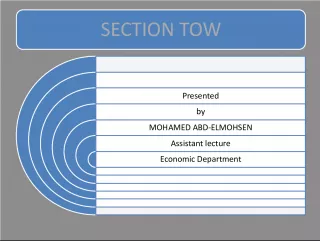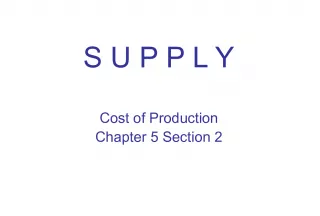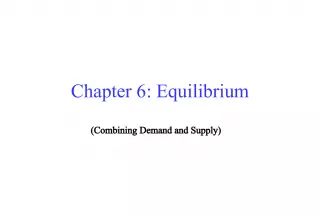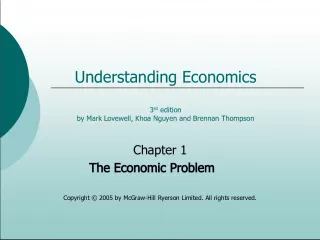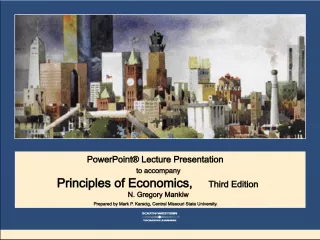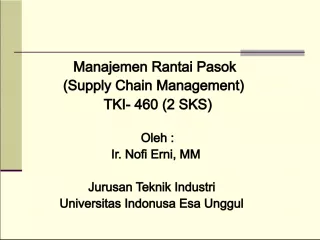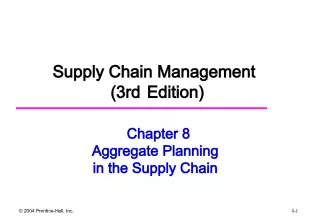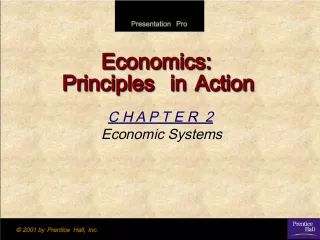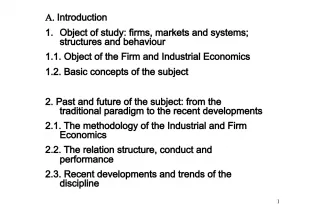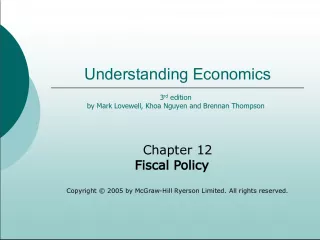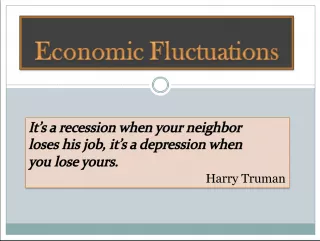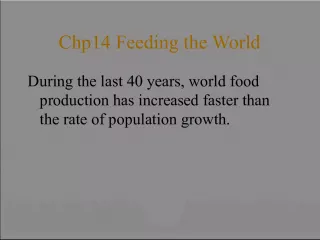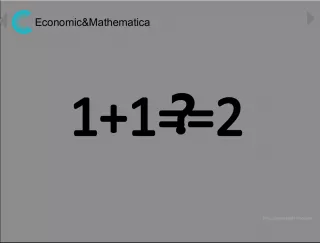Understanding the Law of Supply in Economics


This article explains the law of supply in economics and its key principles, such as changes in supply, elasticity of supply, and equilibrium of demand. The article also provides a definition of supply and its role in determining the amount of a good offered at different prices.
- Uploaded on | 1 Views
-
 jordankoch
jordankoch
About Understanding the Law of Supply in Economics
PowerPoint presentation about 'Understanding the Law of Supply in Economics'. This presentation describes the topic on This article explains the law of supply in economics and its key principles, such as changes in supply, elasticity of supply, and equilibrium of demand. The article also provides a definition of supply and its role in determining the amount of a good offered at different prices.. The key topics included in this slideshow are economics, supply, law of supply, changes in supply, elasticity of supply, equilibrium of demand,. Download this presentation absolutely free.
Presentation Transcript
1. PRINCIPLES OF ECONOMIC Supply Law of Supply Changes in Supply Elasticity of Supply Equilibrium of Demand& Supply BY Ms. Samina Ansari Lecturer of Economics Dep: Economics & Comm Geo DADC
2. DEFINITION OF SUPPLY Supply is a schedule of the amount of a good that would be offered for sale at all possible prices, at any instant of time or during any period of time, e.g. a day , a week & so on.
3. Definition of Law of Supply: If all other things remain the same, the quantity supplied of a product increases as a result of an increase in price and vice- versa.
4. Assumptions of Law of Supply 1- Cost of production (which depends upon) Price of raw material Tax rates Technology & methods of production Wage bill 2- Floods, war etc 3-Change of season 4- Number of producer 5- Political situation
5. Schedule(Law of supply) SUGAR Price (Kg) QS(Kg) P1 (2) Q1 (20) P2 (4) Q2 (40) P3 (6) Q3 (60)
6. Diagram of Law of Supply T h e s u p p l y c u r v e i s u p w a r d s l o p i n g f r o m l e f t t o r i g h t s h o w i n g a p o s i t i v e r e l a t i o n s h i p b / w p r i c e & q u a n t i t y s u p p l i e d . e E c o n o m i c s B a s i c s : D e m a n d & S u p p l y I n v e s t o p e d i a h t t p / / : w w w . i n v e s t o p e d i a . c o m D e m a n d
7. What Does Change In Supply Mean? A term used in economics to describe when the suppliers of a given good or service have altered their production or output. A change in supply can be brought on by new technologies, making production more efficient and less expensive, or by a change in the number of competitors in the market. There are TWO types of change in supply; 1. Movement ALONG the supply curve ( Extension & Contraction of supply). 2. SHIFTS in the supply curve ( Rise & Fall in supply).
8. 1-A movement ALONG the supply curve A movement along the supply curve is caused by a change in PRICE of the good or service. For instance, an increase in the price of the good results in an EXTENSION of supply (quantity supplied will increase), whilst a decrease in price causes a CONTRACTION of supply (quantity supplied will decrease). A rightward shift represents an increase in the quantity supplied (at all prices) S1 to S2, whilst a leftward shift represents a decrease in the quantity supplied (at all prices). S1 to S3.
9. 2-A SHIFT in the supply curve (Rise & Fall in Supply) A shift in the supply curve is caused by a change in any non- price determinant of supply. The curve can shift to the right or left. Basic reasons are in the following. A change in cost of production. A change in the agricultural output. Changes in tax rates. Development of means of transport. Law & order situation. Development in science & technology.
10. RISE IN SUPPLY 1-Supply is said to rise when, at the same price, more quantity is offered for sale by the sellers. 2- The same quantity is offered for sale at low price.
11. FALL IN SUPPLY The fall of supply is opposite to the rise of supply. Thus, when quantity supplied decreases at the same price or quantity supplied remains the same at the higher price: this would be the fall in supply.
12. ELASTICITY OF SUPPLY Definition of Elasticity of supply: Supply elasticity is defined as the percentage change in quantity supplied divided by the percentage change in price. The price elasticity of supply is often summarized by this handy formula: es = % in Qs % in price
13. MEASUREMENT OF ELASTICITY OF SUPPLY PERCENTAG METHOD Percentage change in quantity supplied is measured in relation to percentage change in its price. e s = % change in quantity supplied % change in price Formula: e s = q x p p x q
14. DEGREES OF ELASTICITY OF SUPPLY 1.Equal to unity (es =1) 2.Greater than unity(es>1) 3. Less than unity (es<1)
15. 1 . E q u a l t o u n i t y ( e s = 1 ) If % change in quantity supplied is equal to % change in price elasticity is equal to 1 or unity.
16. 2.Greater than unity (es >1) If % change in quantity supplied is great than % change in price, elasticity will be great than unity
17. 3. Less than unity (es<1) If the % change in amount supplied is less than % change in price than supply elasticity will be less than unity.
18. TWO EXTREMES OF ELASTICITY OF SUPPLY 1- Perfectly Elastic Supply Curve 2- Perfectly Inelastic Supply Curve
19. Perfectly Elastic Supply Curve Definition : When the quantity supplied extends to infinity a certain price. It will be perfectly elastic supply curve.
20. Perfectly Inelastic Supply Curve Definition : When the change in price becomes totally in effective on the quantity supplied of a product the supply becomes perfectly inelastic.
21. EQUILIBRIUM OF DEMAND & SUPPLY & PRICE DETERMINATION What Does Economic Equilibrium Mean? When supply and demand are equal (i.e. when the supply function and demand function intersect) the economy is said to be at equilibrium . Equilibrium Price Equilibrium Quantity Market Equilibrium
22. Equilibrium Price When the price at which the quantity demanded equal to quantity supplied is called Equilibrium Price.
23. EQUILIBRIUM QUANTITY The quantity bought or sold or the amount demanded & supplied at the equilibrium prices is known as equilibrium amount or Equilibrium Quantity.
24. MARKET EQUILIBRIUM When supply and demand reach an agreement, it is called market equilibrium. If a market reaches this point, there is no pressure from any sides to change the prices. The invisible hand leadsto supply and demand. This cartoon shows that equilibrium is the point where supply meets demand in the market.
25. SCHEDULE & DIAGRAM
26. REFERENCES Micro Economics Michel Shams Micro Economics Theory & Application Edger.k.Browing Principles of Economics Abdul Haleem Khawaja Principles of Economics Habib Ullah Waseer
27. T H E E N D
